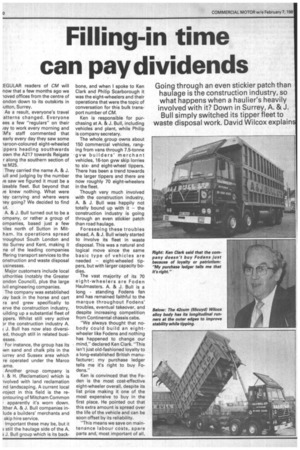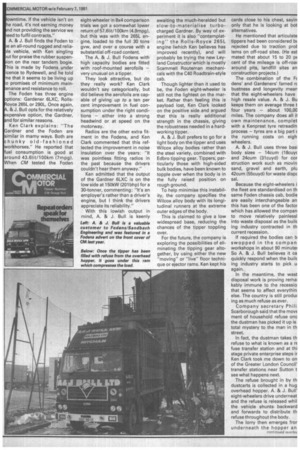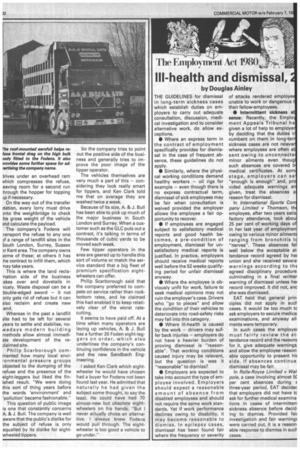Filling-in time can pay dividends
Page 32

Page 33

Page 34

If you've noticed an error in this article please click here to report it so we can fix it.
IEGULAR readers of CM will now that a few months ago we -loved offices from the centre of ondon down to its outskirts in ,utton, Surrey.
As a result, everyone's travel atterns changed. Everyone ees a few "regulars" on their ray to work every morning and TM's staff commented that early every day they saw some roon-coloured eight-wheeled ppers heading southwards own the A217 towards Reigate r along the southern section of ic M25.
They carried the name A. & J. ull and judging by the number re saw we figured it must be a izeable fleet. But beyond that re knew nothing. What were -ley carrying and where were ley going? We decided to find ut.
A. & J. Bull turned out to be a ompany, or rather a group of ompanies, based just a few -flies north of Sutton in Mitham. Its operations spread iroughout South London and ito Surrey and Kent, making it ne of the leading companies ffering transport services to the onstruction and waste disposal usinesses.
Major customers include local uthorities (notably the Greater ondon Council), plus the large ivil engineering companies.
The company was established iay back in the horse and cart ra and grew specifically to erve the construction industry, uilding up a substantial fleet of peers. Whilst still very active Dr the construction industry A. ( J. Bull has now also diversied, though still in related busiesses.
For instance, the group has its wn sand and chalk pits in the ;Liffey and Sussex area which re operated under the Marco ame.
Another group company is & H. (Reclamation) which is ivolved with land reclamation nd landscaping. A Current local Iroject in this field is the reontouring of Mitcham Common apparently it's worn down. )ther A. & J. Bull companies inlude a builders' merchants and skip hire service.
Important these may be, but it 3 still the haulage side of the A. 4J. Bull group which is its back
bone, and when I spoke to Ken Clark and Philip Scarborough it was the eight-wheelers and their operations that were the topic of conversation for this bulk transport number of CM.
Ken is responsible for purchasing at A. & J. Bull, including vehicles and plant, while Philip is company secretary.
The whole_ group owns about 150 commercial vehicles, ranging from vans through 7.5-tonne • gvw builders' merchant vehicles, 16-ton gvw skip lorries to sixand eight-wheel tippers. There has been a trend towards the larger tippers and there are now roughly 70 eight-wheelers in the fleet.
Though very much involved with the construction industry, A. & J. Bull was happily not totally bound up with it — the construction industry is going through an even stickier patch than road haulage.
Foreseeing these troubles ahead, A. & J. Bull wisely started to involve its fleet in waste disposal. This was a natural and logical move since the same basic type of vehicles are needed — eight-wheeled tippers, but with larger capacity bodies.
The vast majority of its 70 eight-wheelers are Foden Haulmasters. A. & J. Bull is a long standing Fodens fan and has remained faithful to the marque throughout Fodens` troubles, eventual takeover, and despite increasing competition from Continental chassis cabs.
"We always thought that nobody could build an eightwheeler like Fodens and nothing has happened to change our mind," declared Ken Clark. "This isn't just old-fashioned loyalty to a long-established British manufacturer; my purchase ledger tells me it's right to buy Fodens."
Ken is convinced that the Foden is the most cost-effective eight-wheeler overall, despite its list price making it one of the most expensive to buy in the first place. He pointed out that this extra amount is spread over the life of the vehicle and can be soon offset by its reliability.
"This means we save on maintenance labour costs, spare parts and, most important of all, owntirne. If the vehicle isn't on he road, it's not earning money nd not providing the service we eed to fulfil contracts."
A. & J. Bull finds the Foden to e an all-round rugged and reliae vehicle, with Ken singling ut for praise the rubber suspenon on the rear tandem bogie. his is made by Fodens under icence to Rydewell, and he told e that it seems to be living up o promises of minimum mainenance and resistance to roll. The Foden has three engine ptions: Gardener 6LXC, Rollsoyce 265L or 290L. Once again, . & J. Bull opts for the relatively xpensive option, the Gardner, nd for similar reasons.
Ken Clark explains: "The Gardner and the Foden are similar in mamy ways. Both are chunky old-fashioned workhorses." He reported that fuel consumption is good at around 43.61it/100km (7mpg). When CM tested the Foden
eight-wheeler in 8x4 comparison trials we got a somewhat lower return of 57.61it/100km (4.9mpg), but this was with the 265L engine, loaded to the full 30 tons gvw, and over a course with a substantial off-road content.
The A. & J. Bull Fodens with high capacity bodies are fitted with roof-mounted aerofoils — very unusual on a tipper.
They look attractive, but do they really work? Ken Clark wouldn't say categorically, but did believe the aerofoils are capable of giving up to a ten per cent improvement in fuel consumption under the right conditions — either into a strong headwind or at speed on the motorway.
Radios are the other extra fitment in the Fodens, and Ken Clark commented that this reflected the improvement in noise insulation over the years: "It was pointless fitting radios in the past because the drivers couldn't hear them anyway."
Ken admitted that the output of the Gardner 6LXC is on the low side at 1513kW (201bhp) for a 30-tonner, commenting: "It's an employer's rather than a driver's engine, but I think the drivers appreciate its reliability."
With this lowish output in mind, A. & J. Bull is keenly Left: A. & J. Bull is a valuable customer to Fodens/Sandbach Engineering and was featured in a Fodens advert on the front cover of CM last year. awaiting the much-heralded but slow-to-materialise turbocharged Gardner. By way of experiment it is also "contemplating" the Rolls-Royce 265L engine (which Ken believes has improved recently), and will probably be trying the new Leyland Constructor which is mostly Scammell Routeman meehanicals with the C40 Roadtrain-style cab.
Though lighter than it used to be, the Foden eight-wheeler is still not the lightest on the market. Rather than feeling this is payload lost, Ken Clark looked on the positive side and argued that this is really additional strength in the chassis, giving the robustness needed in a hardworking tipper.
A. & J. Bull prefers to go for a light body on the tipper and uses Wilcox alloy bodies rather than the steel variety, combined with Edbro tipping gear. Tippers; particularly those with high-sided bulk bodies, have been known to topple over when the body is in the fully raised position on rough ground.
To help minimise this instability, the company specifies the Wilcox alloy body with its longitudinal runners at the extreme outer edges of the body.
This is claimed to give a low widespread base, reducing the chances of the tipper toppling over.
For the future, the company is exploring the possibilities of eliminating the tipping gear altogether, by using either the new "moving" or "live" floor technique or ejector rams. Ken kept his cards close to his chest, sayin only that he is looking at bot alternatives.
He mentioned that articulate tippers had been considered bi rejected due to traction prot lems on off-road sites. (He est mated that about 15 to 20 pf cent of the mileage is off-row around pits, landfill sites an construction projects.)
The combination of the Fc dens' and Gardeners' famed rc bustness and longevity mean that the eight-wheelers have high resale value. A. & J. Bu keeps them on average three t four years — about 100,00 miles. The company does all ii own maintenance, complet with a Kenprest tyre retreadin process — tyres are a big part c the running costs on eigh wheelers.
& J. Bull uses three basi body sizes — 14cum (18cuyc and 24cum (31cuyd) for car struction work such as movin sand, gravel and earth, plu 42cum (55cuyd) for waste dispc sal, Because the eight-wheelers i the fleet are standardised on th same Foden chassis cab, bodie are easily interchangeable an this has been one of the factor which has allowed the compan to move relatively painlessl into waste disposal as the builc ing industry contracted in th current recession.
If required the bodies can b swopped in the compan workshops in about 90 minute: So A. & J. Bull believes it ca quickly respond when the builc ing industry starts to pick u again.
In the meantime, the wast disposal work is proving rem& kably immune to the recessio that seems to affect everythin else. The country is still produc ing as much refuse as ever.
Company secretary Phili Scarborough said that the MOVE ment of household refuse onc the dustman has picked it up is total mystery to the man in th street.
In fact, the dustman takes th refuse to what is known as a rE fuse transfer station and at thi stage private enterprise steps ir Ken Clark took me down to on of the Greater London Council' transfer stations near Sutton t see what happens next.
The refuse brought in by th dustcarts is collected in a hug overhead hopper. A. & J. Bull' eight-wheelers drive underneat and the refuse is released whil the vehicle shunts backward and forwards to distribute th refuse throughout the body.
The lorry then emerges fror underneath the hopper an
irives under an overhead ram Ivhich compresses the refuse, eaving room for a second run hrough the hopper for topping Jp if necessary.
On the way out of the transfer ;tation, every lorry must drive Dnto the weighbridge to check he gross weight of the vehicle and calculate the payload.
The company's Fodens will -ransport the refuse to any one )f a range of landfill sites in the South London, Surrey, Sussex )r Kent area. The company owns some of these; at others it has :he contract to infill them, which -nay take years.
This is where the land reclamation side of the business akes over and dovetails in licely. Waste disposal can be a louble-edged sword — it not Drily gets rid of refuse but it can also reclaim and create new and.
Whereas in the past a landfill site had to be left for several years to settle and stabilise, norvadays modern building methods allow almost immediate development of the reclaimed site.
Philip Scarborough commented how many local environmental pressure groups Dbjected to the dumping of the refuse and the presence of the eight-leggers but liked the finished result. "We were doing this sort of thing years before the words 'environment' and 'pollution' became fashionable."
This question of public image is one that constantly concerns A. & J. Bull. The company is well aware that the public's dislike for the subject of refuse is only equalled by its dislike for eightwheeled tippers. So the company tries to point out the positive side of the business and generally tries to improve the poor image of the tipper operator.
The vehicles themselves are very much a part of this — considering they look really smart for tippers, and Ken Clark told me that on average they are washed twice a week.
Because of its size, A. & J. Bull has been able to pick up much of the major business in South London and Surrey. When a customer such as the GLC puts out a contract, it's talking in terms of thousands of cubic yards to be moved each week.
Few tipper operators in the area are geared up to handle this sort of volume or match the service standard that a big fleet of premium specification eightwheelers can offer.
Philip Scarborough said that the company preferred to compete on service rather than rockbottom rates, and he claimed this had enabled it to keep relatively clear of the worst ratecutting.
It seems to have paid off. At a time when many operators are laying up vehicles, A. & J. Bull has a further 20 Foden eight-leggers on order, which also underlines the company's continuing confidence in the vehicle and the new Sandbach Engineering.
I asked Ken Clark which eightwheeler he would have chosen had a buyer for Fodens not been found last year. He admitted that naturally he had given the subject some thought, to say the least. He could have had 70 almost-new but obsolete eightwheelers on his hands. "But I never actually chose an alternative. I always knew Fodeos would pull through. The eightwheeler is too good a vehicle to go under."












































































































